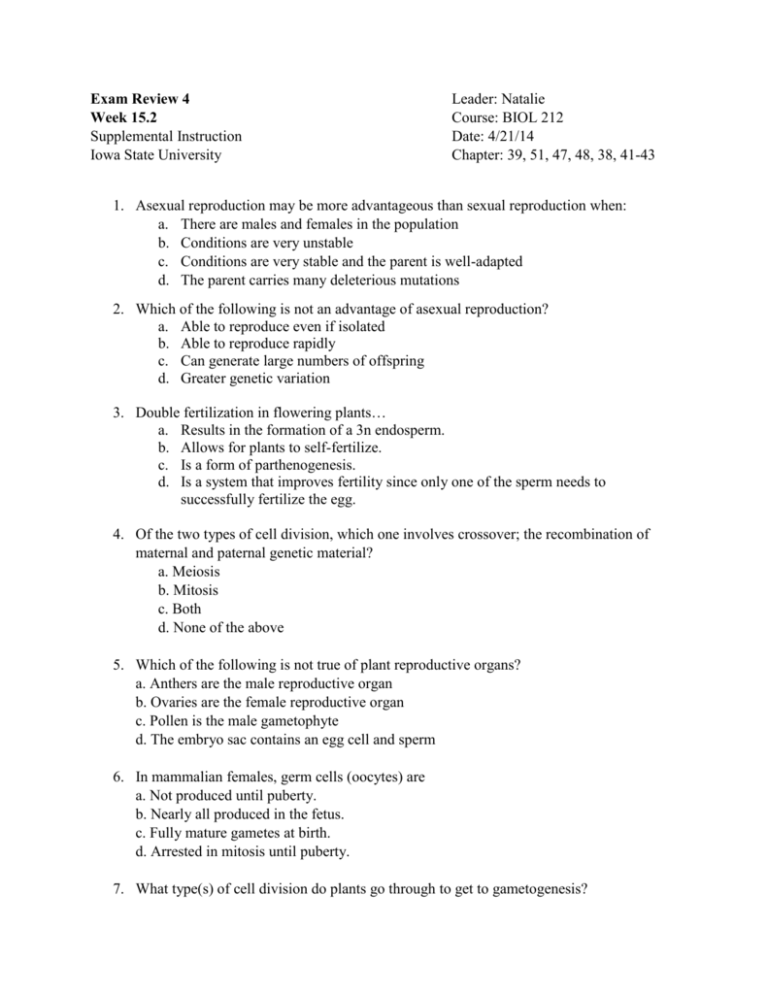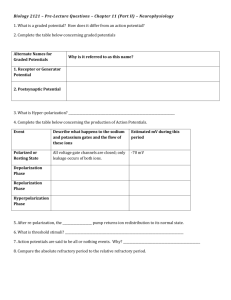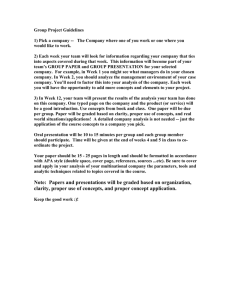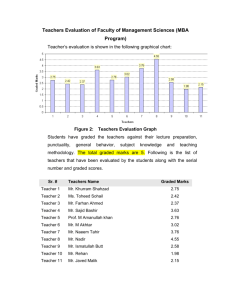Exam Review 4 - Iowa State University
advertisement

Exam Review 4 Week 15.2 Supplemental Instruction Iowa State University Leader: Natalie Course: BIOL 212 Date: 4/21/14 Chapter: 39, 51, 47, 48, 38, 41-43 1. Asexual reproduction may be more advantageous than sexual reproduction when: a. There are males and females in the population b. Conditions are very unstable c. Conditions are very stable and the parent is well-adapted d. The parent carries many deleterious mutations 2. Which of the following is not an advantage of asexual reproduction? a. Able to reproduce even if isolated b. Able to reproduce rapidly c. Can generate large numbers of offspring d. Greater genetic variation 3. Double fertilization in flowering plants… a. Results in the formation of a 3n endosperm. b. Allows for plants to self-fertilize. c. Is a form of parthenogenesis. d. Is a system that improves fertility since only one of the sperm needs to successfully fertilize the egg. 4. Of the two types of cell division, which one involves crossover; the recombination of maternal and paternal genetic material? a. Meiosis b. Mitosis c. Both d. None of the above 5. Which of the following is not true of plant reproductive organs? a. Anthers are the male reproductive organ b. Ovaries are the female reproductive organ c. Pollen is the male gametophyte d. The embryo sac contains an egg cell and sperm 6. In mammalian females, germ cells (oocytes) are a. Not produced until puberty. b. Nearly all produced in the fetus. c. Fully mature gametes at birth. d. Arrested in mitosis until puberty. 7. What type(s) of cell division do plants go through to get to gametogenesis? a. Mitosis (diploid to haploid gametes) b. Meiosis (diploid to haploid spores) c. Mitosis (haploid gametes to haploid spores), meiosis (spores to diploid gametes) d. Meiosis (diploid to haploid spores), mitosis (haploid spores to haploid gametes) 8. Which of the following is true regarding testosterone? a. Low levels indicate female development b. High levels indicate male development c. Only found in male development d. Answers A and B 9. Which of the following is a male? a. XO b. XX c. XXY d. None of the above 10. An individuals with a Y chromosome produces high levels of testosterone has female secondary characteristics. Explain how this is possible. a. A mutation in the testosterone receptor b. They are genetically XXY so they are females c. They are young so they have not reached testis determining age d. None of the above 11. A woman goes into the doctor thinking that she is pregnant. What should the doctor be looking for to confirm that she is pregnant? a. Progesterone levels decrease b. Corpus luteum degenerates c. Estradiol levels decrease d. Production of chorionic gonadotropin which maintains corpus luteum 12. Why are circulatory systems required? a. To transport signaling molecules b. The circulatory system is a transport system needed to overcome the diffusion limitation c. Cells need access to required substances and to eliminate wastes d. All of the above 13. Refer to the figure below. Does myoglobin, fetal hemoglobin, or hemoglobin have a greater affinity for O2? a. b. c. d. Myoglobin, fetal hemoglobin, and hemoglobin have an equal affinity for O2 Myoglobin Fetal hemoglobin Hemoglobin 14. What allows many marine invertebrates (e.g. corals, jellyfish, sea anemones) to grow large in size even though they have only a gastrovascular cavity for circulation? a. these organisms are only a few cells thick and can rely on diffusion to transport nutrients and oxygen throughout the body b. there are many branches within the gastrovascular cavity that directly transport nutrients and oxygen to various tissues c. a single, large heart provides enough pressure to deliver the blood throughout the entire body d. there are many openings to the gastrovascular cavity that allow nutrients and oxygen to be taken up from all directions 15. Cooperative binding of O2 by hemoglobin is physiologically important because a. it overcomes the limitation imposed by diffusion rates b. it allows saturation of blood with O2 at low partial pressure c. it allows hemoglobin to readily give up most of its oxygen at sites of physiological activity d. it increases the O2 carrying capacity of blood 16. Which of the following is false regarding hemoglobin binding to oxygen? a. It is dependent of the partial pressure of oxygen b. It is not reversible c. It is cooperative d. Requires iron Fe2+ 17. Which type of circulatory system allows for the selective delivery of blood to specific tissues? a. Gastrovascular cavities b. Open systems c. Closed systems d. All of the above 18. Which type of blood vessel is the major site of gas exchange? a. Capillaries b. Arterioles c. Arteries d. None of the above 19. Which of the following is incorrect? a. Sieve tube elements are found in phloem b. Companion cells provide mRNA and protein to the sieve cell c. Xylem primarily transports water and dissolved minerals upward d. Tracheids and vessel elements are found in phloem 20. Which of the following would not help in drawing water upward from roots to shoots? a. Root Pressure b. Closed stomates c. Evapotranspiration d. Water flowing into a cell with high solute concentrations inside the cell 21. Root hairs take up mineral ions so that the concentration of minerals is greater inside the root that outside. Which of the following is false? a. The movement of solutes is against the concentration gradient b. The movement of solutes requires active transport c. The movement of solutes does not require ATP d. The movement of solutes into the cell causes high H2O pressure inside the root 22. Which of the following is true regarding neuron structure? a. Signal starts in the axon terminals b. Signal ends in the dendrites c. The axon is continuously covered by a myelin sheath d. None of the above 23. What occurs when the cell becomes less negative relative to surrounding solution? a. Depolarization b. Graded potential helps to trigger action potential c. Na+ channels are open to allow more Na+ into the cell d. All of the above 24. Which of the following statements about graded potentials in neuronal signaling is not true? a. They sometimes involve membrane hyperpolarization b. They sometimes involve membrane depolarization c. They determine whether threshold potential is reached for initiating an action potential d. All of the above statements are true 25. Which of the following statements is true for potentials? a. Graded potential can vary in strength seen by the frequency of graded potentials b. Action potential has an all or nothing response, frequency indicates strength c. Graded potentials are triggered by action potentials d. None of the above 26. What is the correct order of steps in an action potential? a. resting potential, action potential, graded potential, hyperpolarization, return to resting potential b. resting potential, graded potential, action potential, hyperpolarization, return to resting potential c. resting potential, hyperpolarization, graded potential, action potential, return to resting potential d. resting potential, hyperpolarization, action potential, graded potential, return to resting potential 27. Which of the following is false regarding the conduction of an action potential down an axon? a. It involves the opening of voltage-gated Na+ channels to depolarizes the area farther along axon (toward the axon terminals) b. Action potential travels down the axon in a salutatory movement c. Action potential travels down the axon which is non-continuously coated with a myelin sheath made from glial cells d. Backward conduction is prevented by inactivation of K+ channels 28. Which of the following factors contribute to the resting potential in a nerve cell? a. Ion specific channels that allow passive movement of ions b. An ATPase-driven sodium-potassium ion pump. c. Negatively charged molecules such as proteins that are more abundant inside the cell. d. All the above contribute to the resting potential 29. The location for chemical communication between a neuron and a target cell is called the a. motor neuron b. synaptic cleft c. acetylcholine d. axon hillock 30. Which of the following is false regarding chemical signaling? a. Neurotransmitter is kept in vesicles of presynaptic nerve cell b. Action potential opens gated Ca2+ channels c. Ca2+ triggers exocytosis releasing neurotransmitter into synaptic cleft d. Neurotransmitter binding to receptors in the postsynaptic cell always causes an excitatory response 31. In a cell with α-DTX, once an action potential is triggered the cell is slow to return to its resting potential. There could be a problem in: a. Na+ channels opening b. K+ channels opening c. Ca2+ channels opening d. Neurotransmitter release 32. We detect auditory tones because different sound frequencies a. Vibrate auditory sensory neurons at different frequencies b. Vibrate sensory hair cells at different frequencies c. Travel at different speeds through the vestibular fluids in the ear d. Vibrate different parts of the coclea, which are detected by different mechanosensors 33. Which of the following is a common neurotransmitter found in vertebrate neuromuscular junctions? a. Acetylcholine b. Serotonin c. Glutamate d. Dopamine 34. A toxin/ drug/ disease that caused stimulation of a nerve signal would result in? a. Muscle cramping due to constant action potentials b. Muscle cramping due to inability to cause an action potential c. Numbness due to inability to cause an action potential d. Numbness due to constant action potentials





